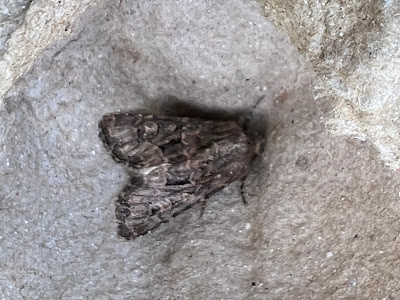Saturday, 31 August 2024
Hitchhiker
Thursday, 29 August 2024
Bluey is Back
Sunday, 25 August 2024
Clickety-click
A curious beetle leads my post today, salvaged from water and a bit dopey but otherwiese apparently unhurt I think that it is a Click Beetle of some kind - so at least says the iBug facility on my son's 'phone - but which one of the UK's many species it is, I cannot say. I see from online references, however, that its name comes from the click it gives when it makes a little jump. Mine was too stunned by its recent immersion to show this talent off.
Thursday, 22 August 2024
Beautiful stinger
I was reading up today about some of the rare close relatives of the Red Underwing which I featured yesterday and a detail about one in particular caught my eye. There has only ever been one Minsmere Crimson Underwing found in the UK, resting on the outside of a light trap in the Minsmere bird reserve in Suffolk in September 20 years ago. Much of the catch inside the trap, says the Moth Bible, 'had been destroyed by hornets.'
Cue my visit to my own trap this morning after a chilly night for the time of the year when I was not expecting rich pickings. Bold as brass on the eggbox nearest the lampholder was the very fine hornet above. Luckily, it did not seem to have destroyed anything.
I have read that hornets are very unaggressive even though they pack a nasty punch in their stings. That has certainly always been my experience. When I find one like this, I always take out its chosen eggbox carefully and chuck it into a bush. Each time serves to remind me to be careful when turning over eggboxes in the Summer. Even the most docile hornet would object to having one of my pudgy fingers squashing it.
Wednesday, 21 August 2024
Petticoats
Tuesday, 20 August 2024
Red Moths in the Sunshine
A pleasant surprise at this time of the year is the daylight appearance of one of our larger moths, the initially modest-looking Red Underwing. It keeps its glories hidden when at rest when it resembles a small Vulcan V-bomber with its camouflage-patterned grey forewings forming a neat triangle.
Its arrival is an annual event but still startles me after so many years of running the light trap, probably because of the fairly routine species of moth which come to the eggboxes during August. This year it was a neighbour who alerted me by sending the top picture of two moths roosting typically in a shady corner which he wanted to identify.
Tuesday, 13 August 2024
Newcomer number seven
One of the moths which I left unidentified in my last post turns out to be another new species for my garden, the seventh this year. I asked for help on the marvellous Upper Thames Moths blog, apologising for being so dim about what looked like some commonplace sort of Rustic species, and the all-knowing expert in charge of that site, Dave Wilton, identified this as the only locally common Olive. Hooray.
I thought briefly that my other failure to identify was an eighth newcomer, a Cabbage moth. I was right in my suggestion but wrong to think that I had never had it here. I checked my list of species and discovered that I was visited by one in our first year here, 2013, and then a Cabbage Moth caterpillar appeared on florets of home-grown broccoli in our fridge four years later.























































